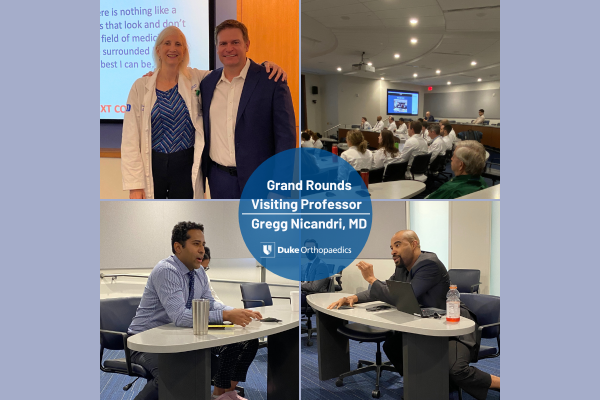
Today, Duke Orthopaedics welcomed Gregg T. Nicandri, MD, Chief Medical Information Officer and Professor of Orthopaedic Surgery from the University of Rochester. He shared, “When I got to Duke for my fellowship, I immediately knew it was the perfect program because of the value placed on mentorship. Faculty member Bill Garrett, MD, learned that I was interested in the simulation curriculum, so he immediately picked up the phone and called the ANNA group to put me on the FAST team. His actions positively changed my career trajectory.”
As Chief Medical Information Officer, he leads a team of workflow engineers at the intersection of patient experience, provider experience, data/analytics, and value. His team strategically leverages technology to automate much of their data and insight generation, enabling them to deliver genuinely personalized healthcare experiences. Using these experiences, Dr. Nicandri discussed ‘Establishing a Comprehensive and Effective Orthopaedic Surgery Simulation Curriculum for Residents’ for Grand Rounds.
“We practice simulation to improve patient outcomes; however, it is critical to measure these actions to determine success. Simulators need to be fit for the curriculum and can be low fidelity, high fidelity, or immersive. At Rochester, we studied and determined that performance on skills assessment is an appropriate proxy for success.” he stated.
During his fellowship at Duke, Dr. Nicandri created the Arthroscopic Surgical Skill Evaluation Tool (ASSET), which remains the prime way to score procedure assessments domestically and internationally. “Proficiency-based education is hard to do using a broad assessment tool. The future will feature technology-based rating systems that review procedure simulation videos in real-time.” He referenced the Artisight platform tool, which performs similarly to Alexa. It creates an operative note in sync with a verbal description and simulation video it records as it is in action via the surgeon’s movements. At the conclusion, the computer will rate the surgeon’s video to determine procedural proficiency.
“Our studies at Rochester showed that residents typically participated in more open cases versus arthroscopic due to the complexity. As a result, simulated experiences were needed to help them learn in conjunction with open surgery,” Nicandri reported.
Dr. Nicandri concluded his presentation by sharing that his next research project involves using artificial intelligence (AI) to decrease the burden of assessments. “I look forward to sharing the knowledge gained with you and our collective orthopaedic surgery colleagues nationwide.”